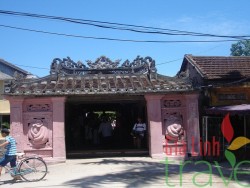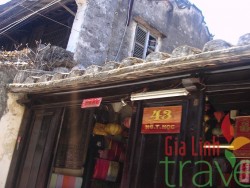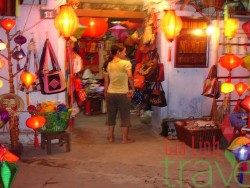Hoi An
Hoi An


Hoi An

Hoi An
The Ancient City of Hoi An
Hoi An, in Quang Nam province, is about 35km south of Danang on the mouth of the Thu Bon river. In the midst of today’s modern municipality is the ancient port town of Hoi an, surrounded by city development. Thanks to the ancient beauty and historical value of this city, Hoi An holiday packages have become the most popular tour in Vietnam.
Dealing with the silted-up river that after made it a major buying and selling centre, it’s now a World Heritage Area and the most desirable destination in any Vietnam tour packages. Its shut proximity to Cua Dai Seashore, good hotels and eating places make it a pleasing place to spend a few days in the middle of a full tour of Vietnam.
Although it’s commercialized, it’s a nicely managed site and retains its ‘village’ atmosphere. Apart from the ancient streets of picket buildings, silk retailers, river trips and a delightful month-to-month ‘return to the previous’ night when visitors and electricity is replaced by lanterns and conventional costumes, are further. I think the astonishing and antique beauty of Hoi An is the main factor that make Hoi An package prevalent.
Hoi An’s History
The Chinese took an interest in the Quang Nam area back within the days of the Cham Empire, and began travelling to Hoi An and anchoring their ships in Tra Nhieu Bay, to the south of Hoi An, however it wasn’t till the early fifteenth century that the area’s potential for commerce was recognized. Later, Hoi An was known as the center of trading and travelling in Vietnam, and up to now has become a famous destination in Asia tour packages.
Originally referred to as Fai Fo, Hoi An was established somewhere between 1602 and 1618 by Nguyen Phuc Nguyen, the ruling ‘Lord’ at that time. He had an in depth relationship with each the Japanese and Chinese language, who have been the first to make use of the new port by way of the commerce winds. The variety of merchants expanded rapidly and by the mid-1600’s ships from Japan, China, Europe India and the South Pacific countries congregated for an annual four-month trading fair.
Fai FO became a melting pot of cultures. Predominant had been the Japanese and Chinese that ran with the trade winds. As lots of the merchants often had to wait several months for favorable winds to carry them home, they established resident communities with their very own rulers, authorized codes and temples.
Many prospered, some reaching the equivalent of billionaires.
Fai FO reached its zenith in the midst of the seventeenth century, when it was among the many largest ports in South East Asia. In direction of the tip of the 18th century, the river started silting up, coinciding with the main target of trade in the area turned in direction of China. Fai Fob’s value as a port dwindled quickly as Danang’s started to develop. By the beginning of the last century, it had turn out to be a backwater, its superb previous merely a memory.
Renamed Hoi An in 1954, the town had reverted right into a sleepy backwater till the fast submit-conflict rise in Vietnam’s inhabitants stimulated a considerable amount of urban development around the Ancient Town. Its economic renaissance was further fuelled by the brand new commerce of tourism generating an explosion of hotels and tourism infrastructure leaving the Ancient Town as an island in the midst of a large conurbation. Since being added to UNESCO’s World Heritage Checklist, the variety of visitors has expanded exponentially, and is now reaching the restrict of the town’s capacity.
What’s there to do in Hoi An?
The centerpiece is, of course, the Ancient Town. It retains the unique road pattern and plenty of its buildings (described separately). Some of the houses and temples take part in a ticket scheme: each 50,000 Dong (roughly $3.40 US) ticket comprises 4 ‘tokens’ permitting guests to choose what attracts them – further tokens cost 10.000 Dong each. The proceeds are directed in the direction of renovation.
Nevertheless, nearly all of the owners of the previous houses are delighted to show visitors around in anticipation of a tip – your tour guide will advise you or deal with it, if you prefer.
Hoi A can also be famous for its many restaurants providing both local and Vietnamese specialties, and international fare. The standard is high, and the prices inexpensive. It’s also a good place for shopping, particularly for silk material and garments. A lot of the silk shops are simply outside the boundaries of the Ancient Cities – most can turn material into a tailor-made garment inside 24 hours.
For early risers, the riverside finish of the town’s market is a fascinating place to be around 05.00 to 06.00 when the evening fishing boats come in to unload their catches.
The islands in the river and other local communities are worth visiting. In the past, there was a thriving community of craft villages; however they declined as the town slipped into obscurity. Nevertheless, some vestiges of the outdated trades are nonetheless to be discovered, reminiscent of boat building on Cam Kim Island. Among the Cam Kim artisans had been ‘recruited’ by boatyards in Ha Long, the place they utilized their abilities to creating the distinctive picket junks which have grow to be a characteristic of the Bay and a popular tourist attraction.
Further away, but accessible by ferry, Cham Island has unspoilt beaches, good snorkeling over coral, and attention-grabbing fishing villages. Its Hai Tung Pagoda dates again to 1758 and although it is close to collapsing, is worth a detour.
About four kilometers from the town is Cua Dai Seaside, part of an infinite strand of sand lining the coast as far as the Mekong Delta. Don’t be misled by references to ‘Vietnam East Sea Beach’ – that’s a bit of Danang’s My Khe beach. Cua Dai is just as good: clear water, and palm/ pine fringed sandy beaches.
When you don’t want to hassle with a taxi of bike, a bicycle is a good approach of getting around – we are able to arrange it in advance, or you can simply hire bikes within the town.
Additional afield, visits to the Marble Mountains and the UNESCO World Heritage Area of the My Son Sanctuary would every take about half a day.
